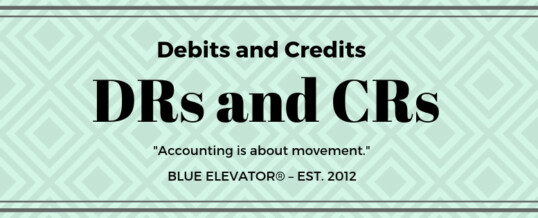
Debits And Credits
Debits and Credits. If you haven’t done so already, I would encourage you to read another article called Two-Five-Two.
In that article, we introduced the two basic financial statements (e.g., the Balance Sheet and the P & L). And, we discussed the five basic accounts.
- Balance Sheet accounts: Assets, Liabilities, and Equity
- P & L accounts: Revenue and Expense
Additionally, each account has a “natural” balance — as either a Debit (DR) or a Credit (CR).
Movement
Accounting is really all about movement — specifically, moving things to where they belong.
Don’t Think: Learn
So, forget about what you’ve heard about DRs and CRs. If we’re honest, we’ve grown up thinking that CRs are good and DRs are bad.
But, DRs and CRs aren’t good and/or bad in-and-of themselves.
For example, you’re excited when the bank CRs your account. And, we all know that a debit (DR) card means money is coming out of your account.
And, believe it or not, the above is correct (when you’re looking at the bank’s books).
But, for now, don’t think about all that. Just learn.
Let me explain.
Natural Balances
Balance Sheet accounts:
- The natural balance of an Asset account is a DR.
- The natural balance of a Liability account is a CR.
- The natural balance of an Equity account is a CR.
Remember, on the Balance Sheet, Assets = Liabilities + Equity. And, DRs = CRs. Just memorize that.
P & L accounts:
- The natural balance of a Revenue account is a CR.
- The natural balance of an Expense account is a DR.
The net result of the P & L (e.g., Profit or Loss) is closed out to the Balance Sheet in the Equity section.
Accounting In A Nutshell
Here’s the very simple and short of it all.
- To increase a DR, you debit it.
- To increase a CR, you credit it.
- To decrease a DR, you credit it.
- To decrease a CR, you debit it.
If you want to increase an account, adjust it in the direction of its natural balance.
If you want to decrease an account, adjust it in the “opposite” direction of its natural balance.
That’s all there is to it.
Good News And Bad News
Next, we’ll tell you how things work. Remember, DRs and CRs are not good or bad in-and-of themselves. But, there are types of movement we would prefer over others.
For example:
- Would you like more Assets (e.g., things of value you own)? Well, yes. The natural balance of an Asset is a DR. So, if you want to increase it, you DR it. So, a DR to an Asset is good news. Whereas a CR to an Asset is bad news.
- Would you like more Liabilities (e.g., things you owe)? Well, no. The natural balance of a Liability is a CR. So, if liabilities increase, you have to CR them. So, a CR to a Liability is bad news. Whereas a DR to a Liability is good news.
- Would you like more Revenue (e.g., more income)? Yes! Now, since the natural balance of a Revenue account is a CR, you CR a Revenue account to increase it. And, that is good news. Now, things can go the other way, too. You can have a DR adjustment to Revenue (e.g., issuing a refund to a customer). This would be bad news.
- Would you like more Expense? No! Remember, the natural balance of an Expense account is a DR. If you incur more expense, then you would have a DR to Expense. And, this is bad news. Additionally, things can go the other way, too. You can have a CR adjustment to Expense (e.g., a vendor sends you a rebate). This would be good news.
Making Sense Of It All
Now that you know a few things, you should be well-equipped to begin your journey.
- There are two main Financial Statements (e.g., Balance Sheet and P & L).
- There are five Basic Accounts. On the Balance Sheet you have Assets = Liabilities + Equity. On the P & L, you have Revenue – Expense.
- And, there are only two types of balances. Either a DR or a CR.
And, now you know how to move things around.
Contact us if you would like more information!
OCT

About the Author:
Ken Moll is the Principal and Founder of Blue Elevator®. With professional experience spanning four decades, Ken has a breadth of foundational business knowledge rarely found – making him part of an elite class of professionals. Ken's passion is helping clients of Blue Elevator® get their “business to the next level™.”